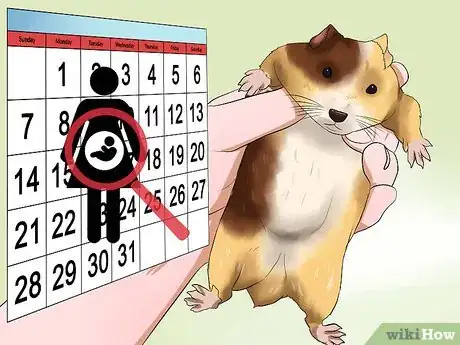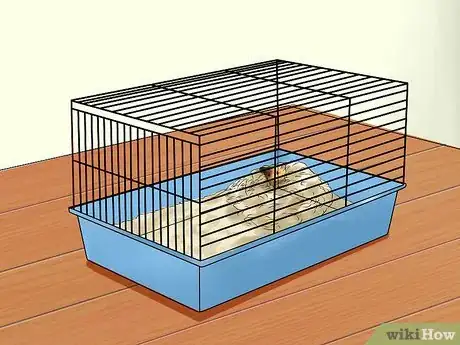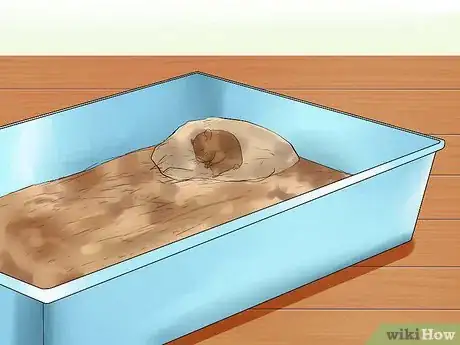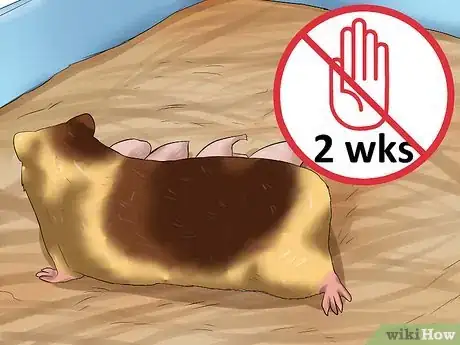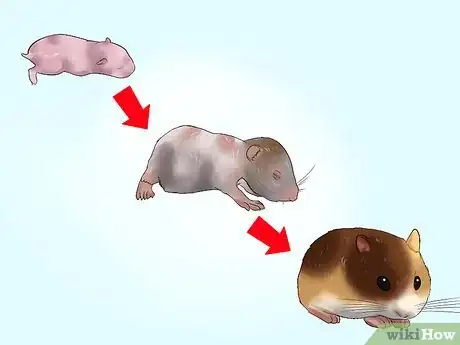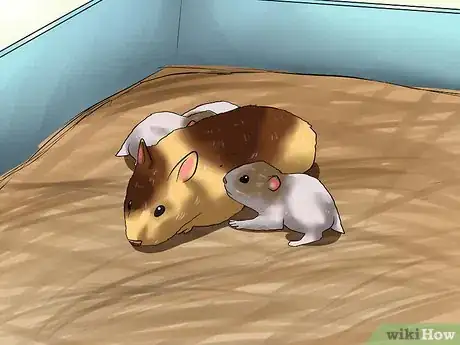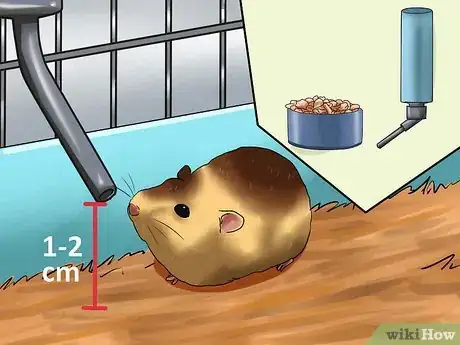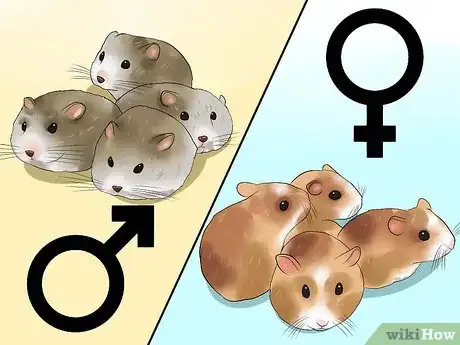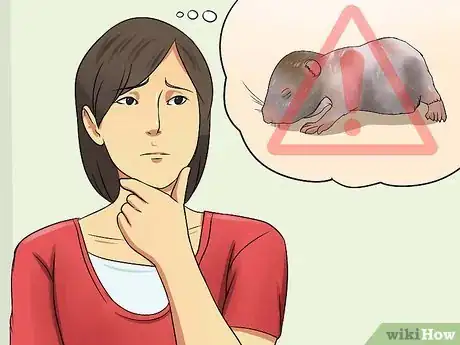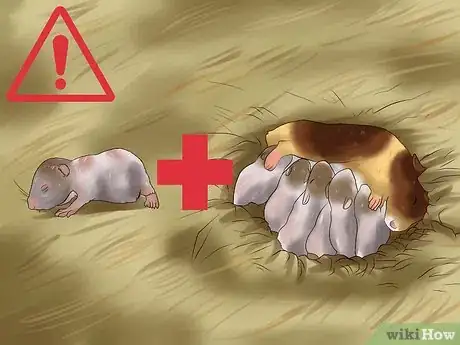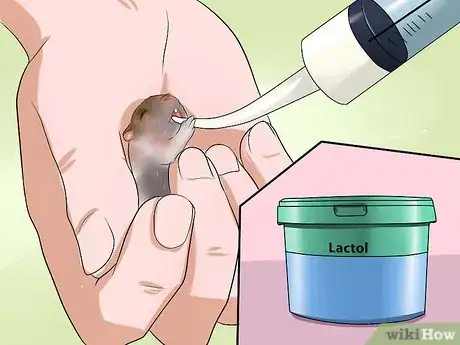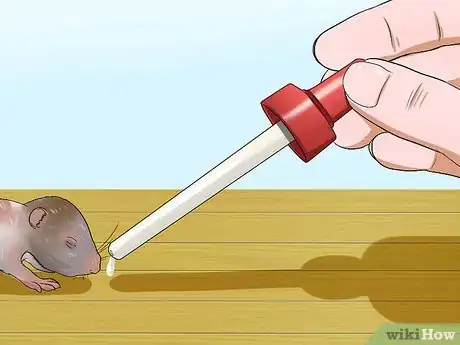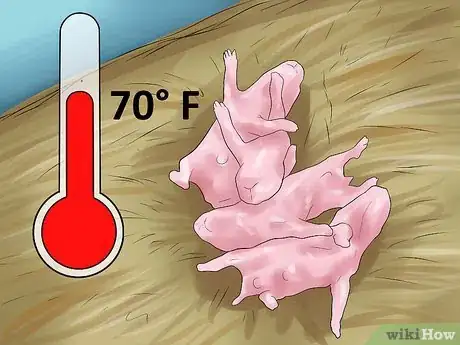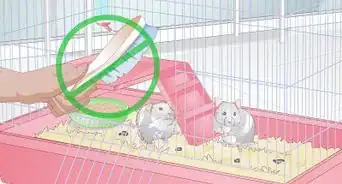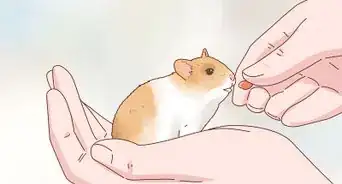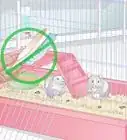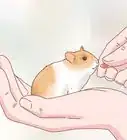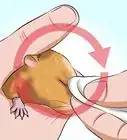This article was co-authored by Pippa Elliott, MRCVS. Dr. Elliott, BVMS, MRCVS is a veterinarian with over 30 years of experience in veterinary surgery and companion animal practice. She graduated from the University of Glasgow in 1987 with a degree in veterinary medicine and surgery. She has worked at the same animal clinic in her hometown for over 20 years.
wikiHow marks an article as reader-approved once it receives enough positive feedback. This article received 13 testimonials and 93% of readers who voted found it helpful, earning it our reader-approved status.
This article has been viewed 134,305 times.
If you have baby hamsters on your hands — whether you bought them or bred them — taking care of them can be a lot of work. Even if the babies are with their mother, you must watch them carefully to make sure she's caring for them properly and not hurting them. Without a mother, hand-reared hamsters have very little chance of survival, even with your dedicated care. There are, however, ways to improve their chances of survival, with or without their mother.
Steps
Preparing a Pregnant Mother for Birth
-
1Assess the parents' risk factors.[1] Hamsters reach sexual maturity as young as 6 weeks old, though it is not advisable to let them mate at this age. A female should be at least 8 - 10 weeks old before mating, and males 10 -12 weeks old. Once a hamster reaches 12 months of age, it should no longer be bred, as health risks skyrocket.
- The average hamster lifespan is 18 - 24 months.
-
2Look for signs of birth. Hamster pregnancies are very short, lasting just 15 - 18 days. When you know your female is expecting, look for the following signs that she's preparing to give birth:
- Restlessness without getting time for exercise
- Nest-building behavior
- Very angry behavior and irritable
- Conscientious grooming
- Squeaking and scratching
- Eating and drinking more than usual
Advertisement -
3Prepare the cage is ready for birth. When you see the signs that the mother is close to giving birth, make sure the babies have an adequate cage to be born into. The cage should be cleaned and prepared before birth, but not too close to the mother's due date. It is important not to disturb the mother in the last few days of pregnancy, as it raises the odds of her cannibalizing the babies.
- A few days before her due date, put her in a clean cage by herself and leave her undisturbed. If you don't know exactly how far along she is, isolate her when you notice her belly swelling.[2]
- Remove toys from the cage. The mum might hurt or kill the babies if toys get in the way.
- Don't use cotton wool or other materials that could form strands on the cage floor, as they could tangle around the babies. Also avoid straw, as the sharp ends could hurt them. Safer alternatives include aspen, paper flakes, Carefresh, or wood fiber pulp.
- Provide the mother with nesting material - something warm she mother can burrow into. Recommended materials include un-dyed tissue paper, toilet paper, or kitchen paper.
- From 2 days before the due-date to 10 days after birth, do not change anything in the cage or handle the mother.
-
4Be sure a nest has been built. When the mother is almost ready to give birth, she will build a breeding nest. Thus, there is no need for you to add any extra housing or move the babies to a separate location. In fact, disturbing the nest after birth could be disastrous. Hamsters are known for cannibalism, and stressing the mother in any way could endanger the babies. This risk is highest the first week after giving birth, and in first-time mothers.[3]
Caring for the Hamster Babies Who Have a Mother
-
1Interfere very little for the first week. After the babies are born, continue to refill water bottles and food dishes for a week, but don't disturb the mother and her babies. Keep them as isolated from traffic and noise as possible — keep curious children, loud TV or radio sounds, and nosy dogs or cats out of the room.
- Do not handle babies at all for 14 days after birth.
- Do not clean the cage for those 2 weeks, either
- Keep the room temperature around 70 F.
-
2Understand how the babies will develop.[4] Hamster babies are born incredibly vulnerable — furless, deaf, blind, and with their limbs are only partially developed. However, they grow and develop very quickly. As they grow, keep these approximate landmarks in mind to make sure they're developing at a healthy, normal rate:
- 4-7 days: eyes and ears should open
- 6 days: they start to crawl around
- 7-10 days: they take an interest in solid food
- 6 days: hair starts to grow
- 10-20 days: they start to be able to drink from a sipper bottle
-
3Let the mother care for her babies. The newborns' best chance of survival is if they have a mother with strong nurturing instincts. You job is to stand back and let her do all the work. If you upset or disturb her, she's more likely to turn on her young, so stay out of her way. With newborn hamsters in the care of a mother, less is definitely more.
-
4Make sure the mother is well-fed.[5] In the first couple weeks, when the babies get all their nutrition from the mother, it's important that the mother is well-fed and healthy. You can choose fresh foods like timothy grass, carrots, and other food, but you can still feed her hamster food.
- Pelleted food suitable for rats or mice is preferable to hamster muesli. This is because the hamster can selectively eat the tastier bits of the muesli, leaving behind the less tasty but more nutritious bits.
-
5Provide food and water for the babies. At around 7-10 days, the babies will be ready to get food and drink from a source other than the mother. Don't put a water bowl in the cage, as they may drown in it. Instead, place a sipper bottle with the nozzle about 1–2 centimeter (0.4–0.8 in) above the bedding. This is in addition to the mother's normally placed bottle — the babies' bottle will be too low for the mother to reach. The babies will begin snacking on their mother's food when they're ready. Once they start to eat solid food, make sure there's plenty to go around.
-
6Separate the hamsters by sex at the appropriate age.[6] Syrian hamsters must be segregated by sex at 3-4 weeks, at which age they will begin to fight. You can leave dwarf hamsters together safely, but you should separate them by sex if you don't want them to mate. This should be done within 48 hours of weaning, which can be done around 21-28 days after birth.
- Puberty starts around 2 - 18 days after weaning. Hamsters are ready to reproduce at this time.
Caring for Orphaned Hamster Babies
-
1Understand the risks. Successfully raising orphaned hamsters is almost unheard of. Newborn hamsters are born very poorly developed, and need a precise balance of nutrition. The mother's milk is the best source for their needs, and manmade replacements won't help them grow healthy organs and bones the same way.[7]
- Don’t be disheartened if the orphans die. Their odds were never good, but at least you gave it a go.
-
2Be very careful using a surrogate mother.[8] Though natural hamster milk is the best source of nutrition for developing babies, hamsters are not very well-suited to surrogacy. Even if you have a lactating female without babies of her own, there's a high likelihood that she would cannibalize any strange babies you put in with her. A non-lacting female won't have the milk the babies need.
-
3Replace the mother's milk as best as possible. The closest you can get to hamster milk is Lactol, which is a milk replacement designed for use with dogs.[9] Hamster pups need strict hourly feeding 24 hours a day until they start to eat solids. Luckily, they usually begin showing interest in solids early, at around 7-10 days. Once they start eating solids, you can reduce their milk feeding to once every three hours.
-
4Use an eyedropper to feed them.[10] Suck some Lactol up in the eyedropper, then squeeze it so a drip hovers on the end of the pipette. Hold the drop against the baby's mouth. Hopefully, it will try to suckle, or at least lick the milk from the tip.
- Avoid squirting milk into the hamster pup's mouth. They're so tiny that even a small amount of fluid could flood down into the hamster's lungs and either drown them or cause pneumonia.
- This is one of the main reasons orphans are so difficult to rear.
-
5Regulate the temperature for them.[11] Hamsters are born furless, so until they're about 10 days old, they cannot regulate their own body temperature. Keep them at a constant temperature of at least 70 F by either using a heat pad or keeping the room at that temperature.
- The babies will be comfortable in temperatures up to 80F. Above this, the youngsters may start to develop heat stress.
- When the pups are in the nest, partially cover them with bedding to help keep them warm.
Expert Q&A
-
QuestionAt what age do baby hamsters start to drink milk?
 Pippa Elliott, MRCVSDr. Elliott, BVMS, MRCVS is a veterinarian with over 30 years of experience in veterinary surgery and companion animal practice. She graduated from the University of Glasgow in 1987 with a degree in veterinary medicine and surgery. She has worked at the same animal clinic in her hometown for over 20 years.
Pippa Elliott, MRCVSDr. Elliott, BVMS, MRCVS is a veterinarian with over 30 years of experience in veterinary surgery and companion animal practice. She graduated from the University of Glasgow in 1987 with a degree in veterinary medicine and surgery. She has worked at the same animal clinic in her hometown for over 20 years.
Veterinarian Baby hamsters are dependent on either suckling milk from their mother or being drip fed milk from a pipette for the first couple of weeks of life. At around 8-9 days of age, the babies may learn to lap milk and become less reliant of hourly feeding from mum or the person rearing them.
Baby hamsters are dependent on either suckling milk from their mother or being drip fed milk from a pipette for the first couple of weeks of life. At around 8-9 days of age, the babies may learn to lap milk and become less reliant of hourly feeding from mum or the person rearing them. -
QuestionCan the mother have milk when the babies are not around?
 Pippa Elliott, MRCVSDr. Elliott, BVMS, MRCVS is a veterinarian with over 30 years of experience in veterinary surgery and companion animal practice. She graduated from the University of Glasgow in 1987 with a degree in veterinary medicine and surgery. She has worked at the same animal clinic in her hometown for over 20 years.
Pippa Elliott, MRCVSDr. Elliott, BVMS, MRCVS is a veterinarian with over 30 years of experience in veterinary surgery and companion animal practice. She graduated from the University of Glasgow in 1987 with a degree in veterinary medicine and surgery. She has worked at the same animal clinic in her hometown for over 20 years.
Veterinarian No. To work out whether it's safe for a hamster to eat or drink a substance, think about whether or not she'd have access to it in the wild. A hamster does not have access to cow's milk, and therefore her digestive system is not equipped to deal with it. There is a chance the milk sugar, lactose, may ferment in her gut and cause diarrhea. This can quickly lead to dehydration, so its much better to play it safe and avoid milk.
No. To work out whether it's safe for a hamster to eat or drink a substance, think about whether or not she'd have access to it in the wild. A hamster does not have access to cow's milk, and therefore her digestive system is not equipped to deal with it. There is a chance the milk sugar, lactose, may ferment in her gut and cause diarrhea. This can quickly lead to dehydration, so its much better to play it safe and avoid milk. -
QuestionWhere can I buy Lactol for my hamsters?
 Pippa Elliott, MRCVSDr. Elliott, BVMS, MRCVS is a veterinarian with over 30 years of experience in veterinary surgery and companion animal practice. She graduated from the University of Glasgow in 1987 with a degree in veterinary medicine and surgery. She has worked at the same animal clinic in her hometown for over 20 years.
Pippa Elliott, MRCVSDr. Elliott, BVMS, MRCVS is a veterinarian with over 30 years of experience in veterinary surgery and companion animal practice. She graduated from the University of Glasgow in 1987 with a degree in veterinary medicine and surgery. She has worked at the same animal clinic in her hometown for over 20 years.
Veterinarian Lactol is replacement formula for dogs, and it is widely available from vets, major pet stores, and online.
Lactol is replacement formula for dogs, and it is widely available from vets, major pet stores, and online.
Warnings
- If you disturb a new mother and her newborn babies, as she might eat them as a self defense mechanism. Stay away for the first week or so.⧼thumbs_response⧽
- If you are in doubt confirm with a reputable breeder to minimize any possible risk.⧼thumbs_response⧽
References
- ↑ Handbook of Rodent and Rabbit Medicine. Laber-Laird & Flecknell. Publisher Pergamon
- ↑ Handbook of Rodent and Rabbit Medicine. Laber-Laird & Flecknell. Publisher Pergamon
- ↑ Handbook of Rodent and Rabbit Medicine. Laber-Laird & Flecknell. Publisher Pergamon
- ↑ Handbook of Rodent and Rabbit Medicine. Laber-Laird & Flecknell. Publisher Pergamon
- ↑ Handbook of Rodent and Rabbit Medicine. Laber-Laird & Flecknell. Publisher Pergamon
- ↑ Handbook of Rodent and Rabbit Medicine. Laber-Laird & Flecknell. Publisher Pergamon
- ↑ http://www.hammysworld.com/index.php?p=handfeeding
- ↑ http://www.hammysworld.com/index.php?p=handfeeding
- ↑ http://www.hammysworld.com/index.php?p=handfeeding
About This Article
To care for newborn hamsters, keep the babies with their mother in a quiet, separate cage for 2 weeks after the birth, disturbing them as little as possible. Additionally, give the mother plenty of nutritious food, such as mice or rat pellets, in the first few weeks to make sure it’s able to feed the babies. After the first week, place a sipper bottle of water low in the cage so the newborn hamsters can reach it. Once the hamsters are 3 weeks old, make sure to separate the males from the females so they don’t start to mate. For advice from our Veterinary co-author on how to feed orphaned baby hamsters, read on!
